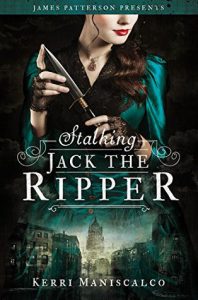 Everyone loves a good ‘whodunit,’ and the most famous of them all are the gruesome murders of Jack the Ripper. Occurring in 1888, Jack the Ripper committed a string of murders so gruesome that “no one, not even the most criminally insane would attempt” (291). In Kerri Maniscalco’s debut novel, the first Young Adult acquisition under James Patterson’s new children’s imprint, she explores the adventures of Audrey Rose Wadsworth, a girl with the knowledge and determination to find the killer who alludes all.
Everyone loves a good ‘whodunit,’ and the most famous of them all are the gruesome murders of Jack the Ripper. Occurring in 1888, Jack the Ripper committed a string of murders so gruesome that “no one, not even the most criminally insane would attempt” (291). In Kerri Maniscalco’s debut novel, the first Young Adult acquisition under James Patterson’s new children’s imprint, she explores the adventures of Audrey Rose Wadsworth, a girl with the knowledge and determination to find the killer who alludes all.
Audrey Rose is a young woman in high society, but she is not the typical young socialite. After her mother’s death years ago, Audrey Rose has been apprenticing under her uncle at night. He’s a forensic scientist who specializes in studying the dead, and Audrey Rose is utterly fascinated by everything she sees in his laboratory. Her father may not approve, but Audrey Rose does not care if others think her a disgrace of a woman. “I was a decent girl, even if I spent my spare time reading about science theories and dissecting the dead” (60). Her studies become far more serious when Scotland Yard becomes faced with violent and disturbing crimes against women. (Be warned, the crime scenes and deaths are described somewhat graphically, though the purpose seems not to shock but rather to be historically accurate).
When Audrey Rose’s uncle becomes the primary suspect, she teams up with his assistant, the brilliant and arrogant Thomas Cresswell. Together, they set out to prove her uncle’s innocence and prove that whoever Jack the Ripper is, “the women he murdered did matter. They weren’t rubbish to be tossed away in the streets” (297). Things only get more complicated, and more dangerous, when Audrey Rose and Thomas begin to see a connection between the dead women they study and someone very close to home…
While Stalking Jack the Ripper is a thrilling and frightening murder mystery, it’s important to reflect on the strength that Maniscalco writes Audrey Rose with. When confronted by insults from her brother towards her “fragile womanly temperament,” Audrey Rose is quick to fight back. “Where in a medical dictionary does it say a woman cannot handle such things? …I had no idea my innards were composed of cotton and kittens, while yours were filled with steel and steam-driven parts” (23). The opposition she faces, as well as the very real danger she is up against, only means that she works harder to be a scientist and detective worthy of praise, no matter her gender. After all, “whether stitching skin or linen, the craft was what mattered, not the medium” (7).
- Posted by Abriana

